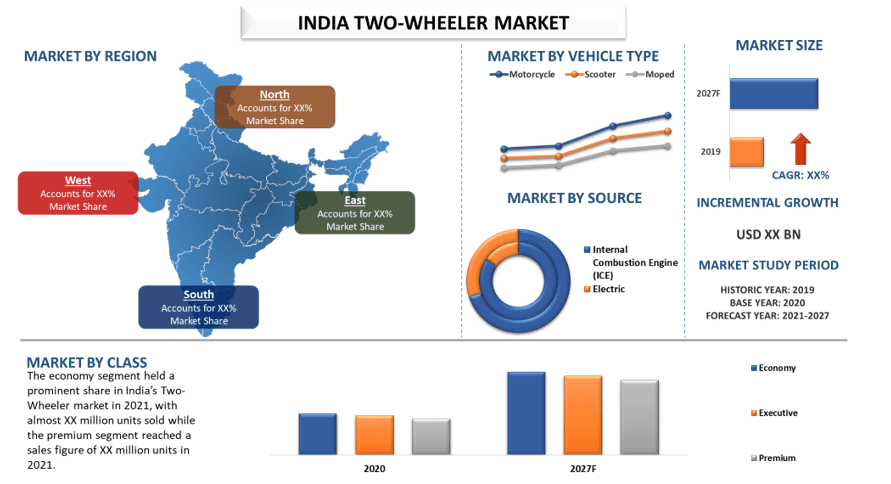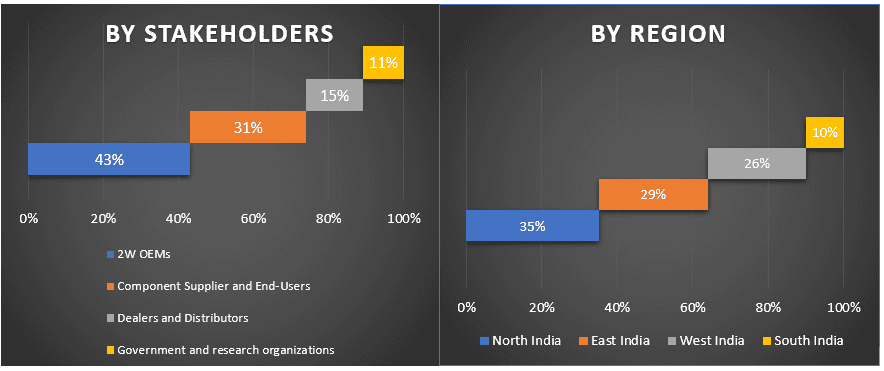- Home
- About Us
- Industry
- Services
- Reading
- Contact Us
India Two-Wheeler Market: Current Analysis and Forecast (2022-2028)
Emphasis on Vehicle Type (Motorcycle, Scooter, and Moped); Source (Internal Combustion Engine (ICE) and Electric); Class (Economy, Executive, and Premium) and Region

The India two-wheeler market is likely to showcase a growth of around 3% during the forecast period. Key factors influencing the growth of India’s two-wheeler market are favorable macroeconomic and demographic trends, increasing workforce participation, improvement in rural income/disposable income and rising government and private sector initiatives for EV adoption. India is a massive market for two-wheelers which accounts for 70% of the 200 million total vehicles running across the length and breadth of this huge nation. This common man’s commute is also responsible for over 20% of the total CO2 emissions, and about 30% of the particulate emissions in urban areas (PM2.5). Since this segment is bound to grow further, there is an urgent need to switch to a cleaner mode, mainly in the urban areas, as 7 of the 10 most polluted cities across the world are in India.
Insights Presented in the Report
“Amongst vehicle type, motorcycle category held prominent market share in 2020”
Based on vehicle type, the market has been segmented into motorcycle, scooter, and moped. The motorcycle was the largest segment in 2021, with almost XX million units sold while performance bike sales merely reached XX million units for the same year India is the second-largest two-wheeler market in the world. It stands next only to China and Japan in terms of the number of two-wheelers produced and the sales of two-wheelers respectively. In 2018, the Indian two-wheeler market accounted for XX million units, and have industry has witnessed a CAGR (Compound Annual Growth Rate) growth of 10.03% over the last three decades. The average number of two-wheelers per 1000 people in India is 31. The urban market for two-wheelers is largely penetrated with nearly 57 of every 100 youths that earn an income to support the ownership of a two-wheeler. The Indian 2-Wheeler industry is dominated by 3 major players, which account for more than 80% share in the industry.
“Amongst source, internal combustion engine category held prominent market share in 2020”
Based on the source type, the market has been segmented into ICE (Internal Combustion Engine) and E2W (Electric 2-Wheeler). ICE (Internal Combustion Engine) segment accounts for the maximum share with nearly XX million ICE 2-wheeler sold in 2021 while only XX million electric 2-wheeler sold in the same year. Currently, the penetration of E2W in India is low compared to the conventional ICE 2-wheelers. However, as per the government plans, the penetration of E2W is expected to grow at an exponential rate. The government wants to increase the adoption of electric vehicles to 100% by 2030. However, most vehicle manufacturers have a different view. As per the automotive experts, the electric vehicle has a huge opportunity; however, the conversion should be in phases.
“North India is expected to witness a significant growth during the forecast period”
India is a massive market for two-wheelers which accounts for 70% of the 200 million total vehicles running across the length and breadth of this huge nation. This common man’s commute is also responsible for over 20% of the total CO2 emissions, and about 30% of the particulate emissions in urban areas (PM2.5). Since this segment is bound to grow further, there is an urgent need to switch to a cleaner mode, mainly in the urban areas, as 7 of the 10 most polluted cities across the world are in India. For instance, 2W penetration in states like Delhi has much higher than the pan-India penetration due to the relatively higher degree of urbanization in the states. With urbanization expected to rise progressively, around 89 million people are estimated to be added to India’s urban spaces over the next decade (78 million people are estimated to have got added over the last decade), which could potentially be one of the most defining changes likely to transpire the 2W Market over the forecast period.
Some of the major players operating in the market include Hero MotoCorp Ltd, Bajaj Auto Ltd, TVS Motor Company, Honda Motorcycle, and Scooter India, Pvt. Ltd, India Yamaha Motor Pvt. Ltd, Suzuki Motorcycle India, Pvt. Ltd, Mahindra, Royal Enfield Motors Ltd, Piaggio Vehicles Pvt. Ltd, Triumph Motorcycles (India) Pvt. Ltd, Hero Electric, Okinawa, Ather Energy, Ampere Vehicles, Revolt, Ola Electric Mobility among others.
Reasons to buy this report:
- The study includes market sizing and forecasting analysis validated by authenticated key industry experts
- The report presents a quick review of overall industry performance at one glance
- The report covers an in-depth analysis of prominent industry peers with a primary focus on key business financials, product portfolio, expansion strategies, and recent developments
- Detailed examination of drivers, restraints, key trends, and opportunities prevailing in the industry
- The study comprehensively covers the market across different segments
- Deep dive country-level analysis of the industry
Customization Options:
India two-wheeler market can further be customized as per the requirement or any other market segment. Besides this, UMI understands that you may have your own business needs, hence feel free to connect with us to get a report that completely suits your requirements.
Table of Content
Analyzing the historical market, estimating the current market, and forecasting the future market of India’s two-wheeler market, three major steps are undertaken to create and analyze its adoption across the globe. Exhaustive secondary research was conducted to collect the historical market numbers and estimate the current market size. Secondly, to validate these insights, numerous findings and assumptions were taken into consideration. Moreover, exhaustive primary interviews were also conducted, with industry experts across the value chain of the India two-wheeler industry. Post assumption and validation of market numbers through primary interviews, we employed a bottom-up approach to forecast the complete market size. Thereafter, market breakdown and data triangulation methods were adopted to estimate and analyze the market size of segments and sub-segments of the industry pertains to. Detailed methodology is explained below:
Seek More Details About Research Methodology
Analysis of Historical Market Size
Step 1: In-Depth Study of Secondary Sources:
Detail secondary study was conducted to obtain the historical market size of two-wheelers through company internal sources such as annual reports & financial statements, performance presentations, press releases, etc., and external sources including journals, news & articles, government publications, competitor publications, sector reports, third-party database, and other credible publications.
Step 2: Market Segmentation:
After obtaining the historical market size of the India two-wheeler market, we conducted a detailed secondary analysis to gather current market insights and share for different segments & sub-segments for major regions. The major segment is included in the report by vehicle type, source, and class. Further regional and country-level analyses were conducted to evaluate the overall adoption of two-wheelers.
Step 3: Factor Analysis:
After acquiring the historical market size of different segments and sub-segments, we conducted a detailed factor analysis to estimate the current market size of two-wheelers. Further, we conducted factor analysis using dependent and independent variables such as growing per capita income, and growing government initiatives for the adoption of electric vehicles in India. A thorough analysis was conducted for demand and supply-side scenarios considering an increasing investment, top partnerships, mergers and acquisitions, business expansion, and product launches in India’s two-wheeler industry.
Current Market Size Estimate & Forecast
Current Market Sizing: Based on actionable insights from the above 3 steps, we arrived at the current market size, key players in the India two-wheeler market, and market shares of each segment. All the required percentage shares split, and market breakdowns were determined using the above-mentioned secondary approach and were verified through primary interviews.
Estimation & Forecasting: For market estimation and forecast, weights were assigned to different factors including drivers & trends, restraints, and opportunities available for the stakeholders. After analyzing these factors, relevant forecasting techniques i.e., the bottom-up approach were applied to arrive at the market forecast to 2028 for different segments and subsegments across the major regions globally. The research methodology adopted to estimate the market size encompasses:
- The industry’s market size, in terms of volume (units) and the adoption rate of two-wheelers across the major markets
- All percentage shares, splits, and breakdowns of market segments and sub-segments
- Key players in the India two-wheeler market. Also, the growth strategies adopted by these players to compete in the fast-growing market.
Market Size and Share Validation
Primary Research: In-depth interviews were conducted with the Key Opinion Leaders (KOLs) including Top Level Executives (CXO/VPs, Sales Head, Marketing Head, Operational Head, Regional Head, Country Head, etc.) across major regions. Primary research findings were then summarized, and statistical analysis was performed to prove the stated hypothesis. Inputs from primary research were consolidated with secondary findings, hence turning information into actionable insights.
Split of Primary Participants by Stakeholders and Regions

Market Engineering
The data triangulation technique was employed to complete the overall market estimation and to arrive at precise statistical numbers for each segment and sub-segment of the India’s two-wheeler market. Data was split into several segments & sub-segments post studying various parameters and trends in the area of vehicle type, source, and class.
The main objective of the India two-wheeler market study
The current & future market trends of two-wheelers were pinpointed in the study. Investors can gain strategic insights to base their discretion for investments on the qualitative and quantitative analysis performed in the study. Current and future market trends would determine the overall attractiveness of the market at a country level, providing a platform for the industrial participant to exploit the untapped market to benefit as a first-mover advantage. Other quantitative goals of the studies include:
- Analyze the current and forecast market size of India’s two-wheeler in terms of volume. Also, analyze the current and forecast market size of different segments and sub-segments
- Segment in the study include the area of vehicle type, source, and class
- Defined analysis of the regulatory framework for the India two-wheeler industry
- Analyze the value chain involved with the presence of various intermediaries, along with analyzing customer and competitor behaviors of the industry
- Analyze the current and forecast market size of India’s two-wheeler for the major regions
- Major regions analyzed in the report include North India, East India, West India, and South India
- Company profiles of the India two-wheeler market players and the growth strategies adopted by them to sustain in the growing market
Deep dive country-level analysis of the industry
Related Reports
Customers who bought this item also bought










